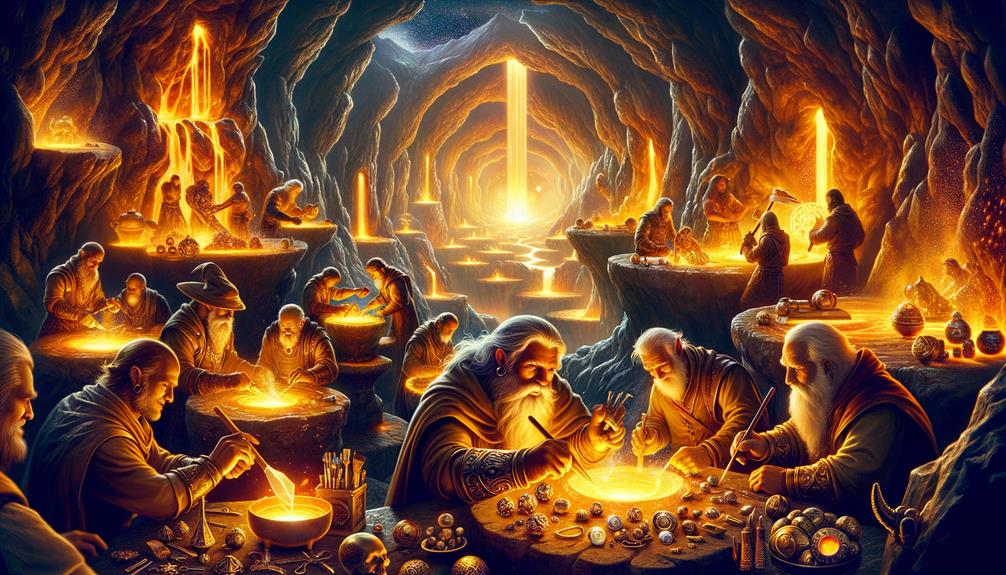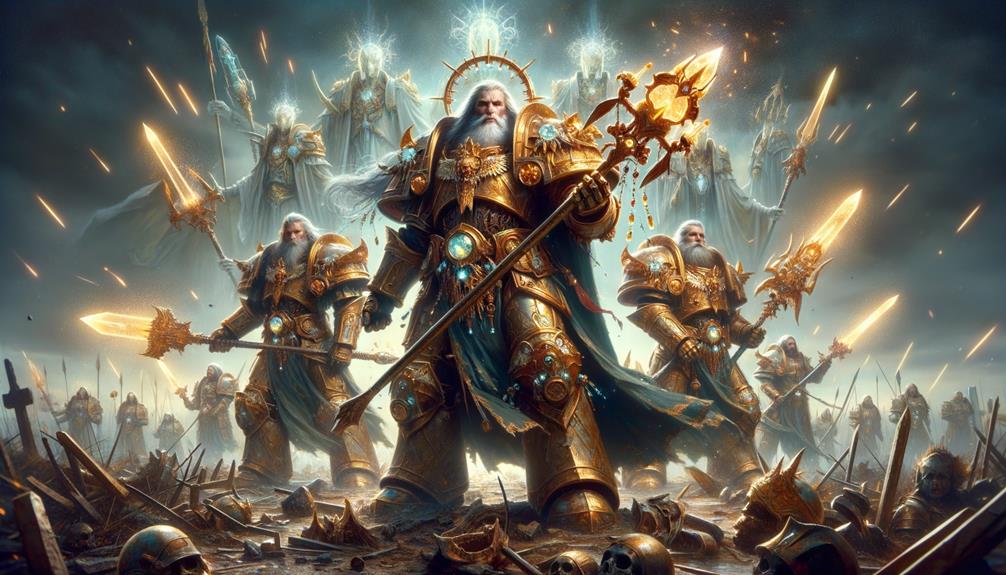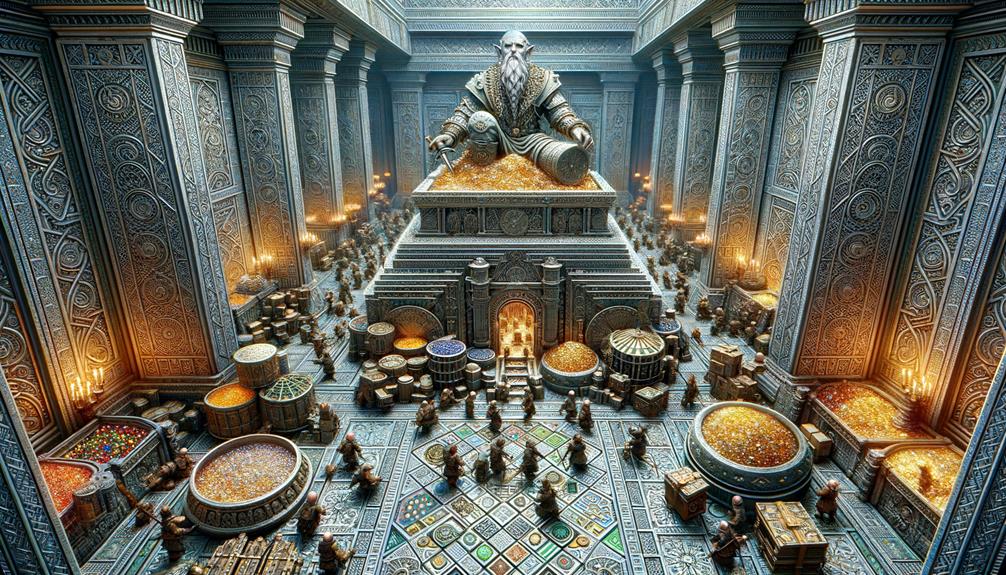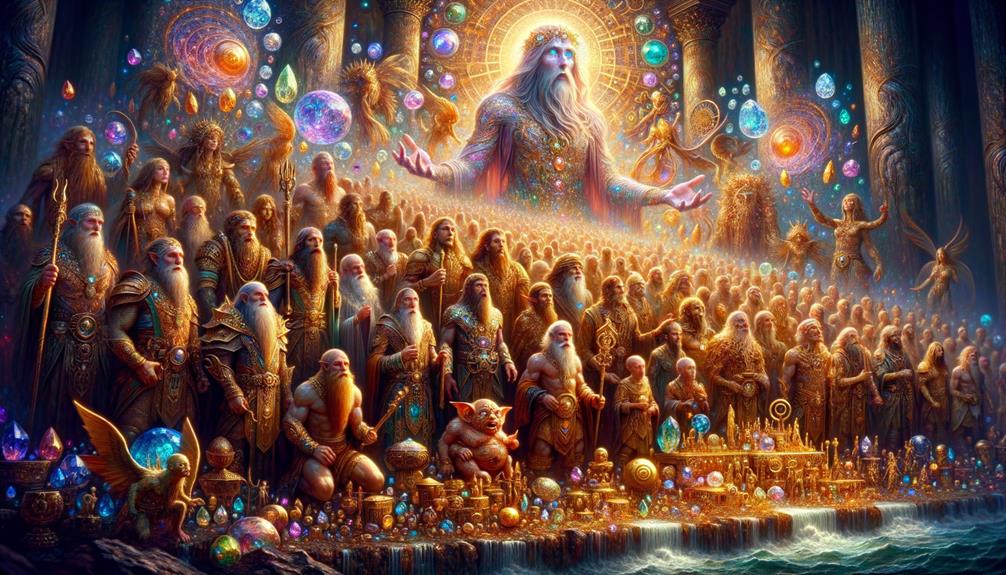The stories from Norse mythology often tell us about dwarves who were renowned for their incredible craftsmanship. Their masterpieces were not just beautiful to look at but were also crafted from divine metals, showcasing the extraordinary talent of these dwarven artisans. Some of the most famous of these craftsmen were figures like Ivaldi, Brokk, and Eitri.
These treasures were much more than just a show of wealth or status. They had unique characteristics and powerful magic, much like Sif's golden hair or Odin's spear, Gungnir. The impact they had on mythical battles was significant, just as they would be in a game of Dwarf Fortress.
We can learn a lot from these stories, whether it's gaining an appreciation for the artistry of the dwarves or learning how to strategize for protecting treasures. The tales offer plenty of lessons, just waiting to be discovered.
Understanding Dwarven Divine Artifacts
Let's talk about the fascinating realm of Dwarven divine artifacts. These splendid creations, skillfully forged from sacred metals, serve not only as a symbol of prestige for a Mountainhome fortress but also significantly boost a dwarf's combat skills. It's interesting to draw similarities between these artifacts and the Norse mythology of Sif's golden hair, Odin's spear Gungnir, and the ring Draupnir, all of which were created by the dwarf brothers Brokk and Eitri.
Just as Sif's hair shone with an otherworldly charm, these divine artifacts radiate an enchanting glow, a symbol of a fortress's standing. Like Gungnir, these artifacts augment a dwarf's fighting abilities, transforming them into formidable rivals. And akin to Draupnir, these artifacts stand as a testimony to the skill and craftsmanship of their makers.
However, similar to how Sif's golden hair was initially concealed, these artifacts can often be elusive, largely due to the absence of visual representations. Let's continue to delve into this captivating world, appreciating the beauty and power of these divine artifacts.
Significance of Treasures in Dwarf Fortress

So, let's chat about the importance of treasures in Dwarf Fortress, a popular game. You know how in Norse mythology, the gods have these amazing treasures that are not just beautiful but also magical? Well, it's quite similar in Dwarf Fortress.
Take the golden hair of Sif, for example, a Norse treasure made by Ivaldi's sons. This isn't just any old hairpiece; it can actually grow like real hair! In Dwarf Fortress, the treasures made by the dwarves also have their own unique qualities, much like Sif's hair.
And then there's Odin's spear, Gungnir – a weapon that never misses its target. Well, the game's dwarven creations are just as precise, a testament to their skill.
Ever heard of the ship Skidbladnir from Norse mythology? It's this really cool ship made by the brothers Brokk and Eitri that can actually be folded up small enough to fit into your pocket! In Dwarf Fortress, this sort of space manipulation is a common theme amongst the dwarves' creations.
But these treasures aren't just cool features of the game. They're important pieces of the story, weaving a rich tapestry of narrative into the gameplay. So next time you come across a treasure in Dwarf Fortress, remember it's not just a trinket – it's a piece of dwarven history.
Crafting Process of Divine Metals

Just like the fantastical items found in Dwarf Fortress, Norse mythology's dwarves were famous for their artistry in crafting divine metal treasures. These included Mjölnir and Gungnir, renowned pieces that possessed unique magical properties and were greatly valued by the gods. Master craftsmen like Ivaldi, Brokk, and Eitri were the brains behind these divine metals. The way they worked these materials was more than just a skill; it was a highly respected art form. It represented the dwarfs' meticulous nature and their inborn talent for metalwork. Each item they produced was one of a kind, with magical attributes – some could always hit their target, while others could make rings. The gods themselves were the judges of these treasures, with Thor's hammer Mjölnir receiving the highest praise. In essence, the craftsmanship of the dwarfs was a divine partnership – their treasures were symbols of the gods' favor and power.
Battle Advantages of Dwarves Treasures

The craftsmanship of the dwarves is nothing short of amazing, and their creations, like Mjölnir and Gungnir, gave the gods a serious leg up in battles, influencing the outcome of many mythical fights. Let's take Mjölnir as an example. This hammer, rich with the expertise of a dwarf, could decimate mountains, providing Thor with a strong defense against giants. On the other hand, Odin's spear, Gungnir, was designed to always hit its mark, giving him the sharpness of a hawk spotting a ring on the ground. You could think of it as comparing a boat to long strands of golden hair, with each strand representing a distinct advantage.
These treasures aren't just shiny symbols of wealth; they're powerful weapons. Each strand of golden hair, each ring, each boat, all are a testament to the skill of the dwarves, giving the gods an edge in combat and asserting their dominance in battle.
Strategies for Securing Dwarven Treasures

Alright, let's chat about the strategies we can use to secure these incredibly desired Dwarven treasures, known for their immense power in battles involving the gods.
- Playing It Safe: If you know your Norse Mythology, you'll remember the dwarf brothers. They were the ultimate masters in keeping these treasures safe. We can learn a thing or two from their meticulous methods.
- Sif's Golden Hair: This isn't just a pretty artifact. The dwarf brothers put their heart and soul into making this piece, and it turned out to be a great tool for protection. Keep an eye out for similar objects that can aid in the security of your treasures.
- The Boar Gullinbursti: This isn't your average boar. Crafted by the dwarf brothers, this creature was a symbol of protection and strength. Let's use their mythological wisdom in our own treasure-securing strategies.
Frequently Asked Questions
What Gifts Did the Dwarves Make for the Gods?
I've always had a deep respect for the quality of work that comes from dwarves in mythology. They've created some pretty cool things for the gods, you know? There's Sif's golden hair, for instance – can you imagine the level of detail and precision that went into crafting that? Then there's the ship Skidbladnir, and the spear Gungnir. Truly, the gods were thankful for the gifted hands of the dwarves.
Which Is the Greatest Treasure That the Dwarves Created?
If you ask me, the most remarkable piece ever fashioned by the dwarves has to be Mjölnir, the hammer of Thor. Its mythical status and the skills of dwarven metalwork it represents, underscore its value not just as a treasure, but as a divine emblem that's truly admired.
What Are the Dwarven Treasures in Norse Mythology?
Isn't it amazing how rich Norse mythology is? The dwarves are known for their exceptional skills in crafting, creating such wondrous items as Sif's golden hair, the ship Skidbladnir, and the spear Gungnir. These extraordinary creations are not just symbols of the dwarven society's abilities, but also represent their intricate ties with the gods.
What Are the Three Gifts Brok and Sindri?
Brok and Sindri, renowned for their exceptional smithing skills and imaginative designs, are known to have crafted three noteworthy gifts: Gullinbursti, Draupnir, and Mjölnir. This act of generosity, deeply rooted in Dwarven culture, adds a rich layer to our understanding of Norse mythology.


